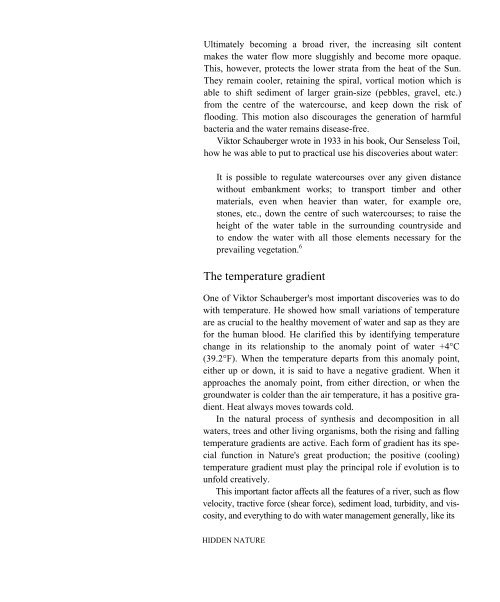levitational current - Free Energy
levitational current - Free Energy
levitational current - Free Energy
You also want an ePaper? Increase the reach of your titles
YUMPU automatically turns print PDFs into web optimized ePapers that Google loves.
Ultimately becoming a broad river, the increasing silt content<br />
makes the water flow more sluggishly and become more opaque.<br />
This, however, protects the lower strata from the heat of the Sun.<br />
They remain cooler, retaining the spiral, vortical motion which is<br />
able to shift sediment of larger grain-size (pebbles, gravel, etc.)<br />
from the centre of the watercourse, and keep down the risk of<br />
flooding. This motion also discourages the generation of harmful<br />
bacteria and the water remains disease-free.<br />
Viktor Schauberger wrote in 1933 in his book, Our Senseless Toil,<br />
how he was able to put to practical use his discoveries about water:<br />
It is possible to regulate watercourses over any given distance<br />
without embankment works; to transport timber and other<br />
materials, even when heavier than water, for example ore,<br />
stones, etc., down the centre of such watercourses; to raise the<br />
height of the water table in the surrounding countryside and<br />
to endow the water with all those elements necessary for the<br />
prevailing vegetation. 6<br />
The temperature gradient<br />
One of Viktor Schauberger's most important discoveries was to do<br />
with temperature. He showed how small variations of temperature<br />
are as crucial to the healthy movement of water and sap as they are<br />
for the human blood. He clarified this by identifying temperature<br />
change in its relationship to the anomaly point of water +4°C<br />
(39.2°F). When the temperature departs from this anomaly point,<br />
either up or down, it is said to have a negative gradient. When it<br />
approaches the anomaly point, from either direction, or when the<br />
groundwater is colder than the air temperature, it has a positive gradient.<br />
Heat always moves towards cold.<br />
In the natural process of synthesis and decomposition in all<br />
waters, trees and other living organisms, both the rising and falling<br />
temperature gradients are active. Each form of gradient has its special<br />
function in Nature's great production; the positive (cooling)<br />
temperature gradient must play the principal role if evolution is to<br />
unfold creatively.<br />
This important factor affects all the features of a river, such as flow<br />
velocity, tractive force (shear force), sediment load, turbidity, and viscosity,<br />
and everything to do with water management generally, like its<br />
HIDDEN NATURE








![The Big Lie 9-11 and Government Complicity in Mass Murder [PDF]](https://img.yumpu.com/50957077/1/190x245/the-big-lie-9-11-and-government-complicity-in-mass-murder-pdf.jpg?quality=85)








